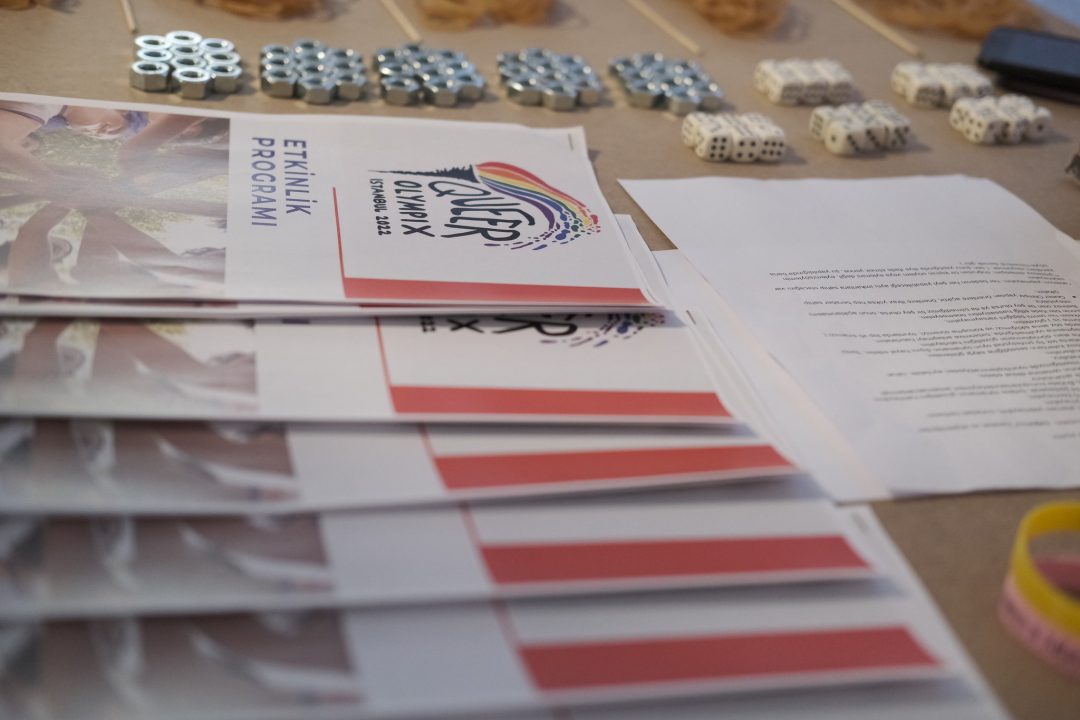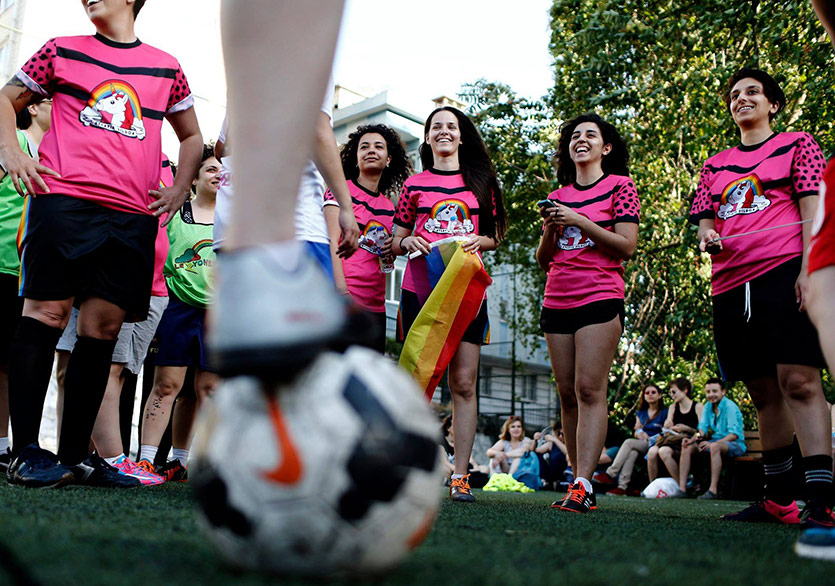Purpose
The purpose of this policy document is to cleanse the internal functioning and interactions of Queer Olympix from sexual violence and all forms of gender-based inequality and discrimination; to prevent and deter them, and to establish effective mechanisms that promote gender equality and embrace non-violence in such situations and circumstances.
Sources
This document has been prepared based on the Convention on the Elimination of All Forms of Discrimination against Women (CEDAW, 1985), the Council of Europe Convention on preventing and combating violence against women and domestic violence (Istanbul Convention, 2011), the Turkish Penal Code Law No. 6284 on the Protection of Family and Prevention of Violence against Women, and by adopting the approach of the International Labour Organization (ILO) Convention No. 190 on the Elimination of Violence and Harassment, and by examining the experiences and practices of civil society organizations.
Concepts
1- Survivor: The person subjected to sexual violence. Instead of terms such as “victim” or “perpetrator,” the term “survivor” may be more empowering for these individuals. Of course, the individual themselves decides which term to use.
2- Perpetrator: The person or institution causing any form of violence against another person or persons.
3- Sexual Violence: A comprehensive concept that defines any action, behavior, or intervention directed at or involving sexuality without consent, with or without the attempt to obtain consent, or where consent cannot be given. In this context, sexual harassment, sexual assault, dating violence, persistent pursuit, and retaliatory sexual violence are included under the definition of sexual violence.
4- Sexual Harassment: Refers to unwelcome, non-physical sexual actions, words, and behaviors conducted without the individual’s consent. This includes sending sexual messages without consent, making jokes, making suggestive comments, persistently soliciting a relationship, exposing genitals, describing sexual experiences, humiliating or degrading a person sexually.
Repeated behaviors or a single incident can be considered sexual harassment. Continuity is not a precondition. The following examples, while not exhaustive, can constitute types of sexual harassment.
Actions that create uncomfortable, unwanted environments:
- Making jokes, making sexually suggestive remarks and compliments, or using vulgar language,
- Engaging in persistent behaviors for flirting,
- Disturbing with pornographic material,
- Asking questions about the person’s sexual life despite expressing discomfort.
Actions aimed at controlling the person’s behavior:
- Not accepting “no” as an answer, engaging in persistent behaviors,
- Spreading gossip,
- Threatening, blackmailing, or insulting,
- Following, harassing in electronic media,
- Sharing information, correspondence, or photos, etc., related to the person’s sexual life without their consent, verbally, with real materials, or digitally.
5- Sexual Abuse: Acts of sexual assault and sexual harassment committed against individuals under the age of 18 or those lacking the capacity to consent.
6- Sexual Assault: Involves the non-consensual or non-consultative violation of bodily integrity in sexual nature. The following examples, while not exhaustive, can constitute types of sexual assault.
- Hugging, touching, caressing, or groping,
- Inserting a sexual organ or an object into the body.
Even if not carried out, attempts to commit these acts are also considered sexual assault.
7- Dating Violence: Harmful behavior patterns where one partner in an emotional, romantic, or sexual relationship, or after the relationship ends, seeks to gain power and control over the other or each other.
8- Persistent Pursuit: Physically or virtually stalking, intruding into the individual’s personal space and boundaries, persistently and systematically applying violence by refusing to accept the “no” answer and causing threats and fear.
9- Retaliation: The forced complication of work or education life overtly or covertly due to rejecting sexual or emotional offers, complaining about harassment experienced, or attempting to take action. Similarly, witnessing retaliation actions against a witness related to a sexual harassment incident is considered a violation of this policy text, and appropriate action is taken accordingly. Likewise, any promised privilege or reward for accepting sexual or emotional advances is considered a form of harassment.
10- Emotional Violence: Emotional violence is to weaken and devalue the person in some way. Whether systematic or not, it is a situation that undermines a person’s self-confidence, self-worth, as well as self-perception and self-identity.
Examples of emotional violence:
Using insulting and violent swearing that is already hurtful. For some, this may not be seen as a violent act because they believe that using homophobic language among LGBTQ+ individuals (as both parties are LGBTQ+) is not a problem. However, since these words are still used to hurt the other person, the fact that what is said could be said to both parties does not diminish the impact of the statement. This situation can be triggering for those who have experienced hate violence.
Questioning and using it as an insult the reality of someone being LGBTQ+/queer. Similarly, questioning a heterosexual person’s sexual orientation.
Using suppressive language and actions towards a person’s gender identity/expression, gender characteristics, sexual orientation, or sexual experience.
Forcing someone to keep their identity hidden, preventing people from coming out.
Disparaging, restricting, or controlling expressions of gender and sexuality in any way. This is not exclusive to LGBTQ+ identities, but in cases where it is, for example, making someone feel too much or insufficient (femme, feminine, masculine, butch, conforming to gender norms, deviating from gender norms, weak, fat). Persistently trying to confine non-binary identities within the binary gender identity boundaries.
Rewarding/punishing behaviors related to gender and sexuality.
It is a type of violence and harassment that many people find difficult to recognize, applied in a subtle way. Those experiencing this violence may feel that something is wrong. They may not be able to identify what causes the stress, depression, or anxiety they feel. Difficulty in understanding that someone’s actions are “violent” is inherent in experiencing emotional violence. Unlike physical violence, which leaves visible marks, emotional violence is often not seen or felt by anyone other than the person experiencing it. This also means that emotional violence can occur anywhere and at any time. It is not uncommon for someone experiencing violence to blame themselves, and the power imbalance in the relationship often reinforces self-doubt.
11- Gaslighting: A type of emotional violence that can be defined as continuously manipulating someone to doubt their perception and memory, with the intention of gaining emotional/material benefits. The criterion is the perpetrator’s conscious action for emotional/material gain. The manipulation methods that can be applied can vary widely. What is constant for gaslighting can be said to be “constantly making the survivor doubt their own reality, perception, and memory” through the experiences they have had. However, situations such as feeling guilty or finding oneself apologizing while trying to articulate the problem due to experiencing gaslighting can be considered as gaslighting, regardless of whether the perpetrator acts consciously or unconsciously.
12- Mobbing: Psychological pressure systematically applied by one or more people to another person using hostile and unethical methods. It is commonly used to describe pressure, violence, and intimidation in the workplace. Questioning professional competence, making the person feel untrustworthy, assigning tasks that cannot be completed within the given time intentionally, withholding information from the person, ignoring the person, isolating them from the group, and/or reducing their authority are indicators of mobbing.
13- Violence Cycle: In situations
involving violence, it refers to the continuation of violent behaviors within a certain cycle. The parties perpetrating violence often apologize after the first violent behavior, promising that it will never happen again, convincing the person to stay in the relationship. However, research shows that if a violent behavior occurs once in a relationship, the likelihood of it happening again is high.
The violence cycle can consist of several stages:
- Stage – Escalation of tension: Interruption in communication, increase in fear and anxiety.
- Stage – Violent behavior: Insults, threats, verbal/emotional/physical/sexual/economic violence.
- Stage – Reconciliation: Apology, justification of violence, promise of change, gifts.
- Stage – Calmness: Ignoring what happened, non-violent communication.
Although each relationship is different and unique, the spreading of violent behaviors over time and becoming more harmful for the survivor is a common characteristic of unsafe relationships. This makes it harder for the survivor to realize the violence they are experiencing and to leave the relationship involving violence. Therefore, knowing how the violence cycle works and taking preventive measures is important.
- Perpetrator’s Self-Transformation: Not closing the areas where the perpetrator can change and transform violent behaviors. This does not mean compromising in the face of injustice, exploitation, and violence. It is to provide the necessary tools to recognize the legitimate needs of the parties and to provide a restorative approach. The goal is inclusive solutions.
Commitment
Queer Olympix volunteers commit to providing an egalitarian, non-violent preparation process and event environment for volunteers and participants through this policy document; and pledge that no form of sexual violence will be ignored in any way.
Preventive and Protective Measures
It is aimed to raise awareness among our volunteers in this field and reinforce their knowledge through regular non-violence and gender equality policy development training and workshops.
Support Group Against Sexual Harassment and Assault
In this context, a “Support Group Against Sexual Harassment and Assault” has been established to enable complaints regarding sexual harassment and assault to be made and to activate support mechanisms. The tasks of the group are as follows:
To review complaints of sexual harassment, sexual violence, sexual assault, and sexual abuse and to address applications regarding discriminatory and/or violent behaviors based on gender equality without delay and with diligence.
The group’s responsibility is not to conduct an investigation, but to ensure that the process is transparent and conducted in a way that respects the needs and safety of the survivor and to prevent the survivor from being harmed again in any way.
The group is responsible for not leaving complaints unresolved and for developing support mechanisms for survivors.
The group is obligated to respond to the complaint within one week at the latest. The process regarding the complaint is carried out within 30 days.
In cases where it is deemed necessary, one of the group members is directly or indirectly (as a witness) consulted.
In addressing sexual harassment allegations, the group adheres to the principle of confidentiality of the private lives of the complainant and the accused at all stages. If this confidentiality is breached, the group members are expected to engage in self-criticism and their involvement in future activities and processes is suspended.
If there is a situation with one of the group members that could affect the impartial conduct of the process, that group member does not participate in the support group.
Since independent experts are contacted for the conduct of the process, group members must ensure that this communication is conducted transparently and in a way that protects the survivor.
Group members should have access to psychological and legal support from professionals working in the field when needed for possible traumatic conditions they may experience or may encounter during the process.
- This document was updated on July 27, 2022. –


 Turkish
Turkish

